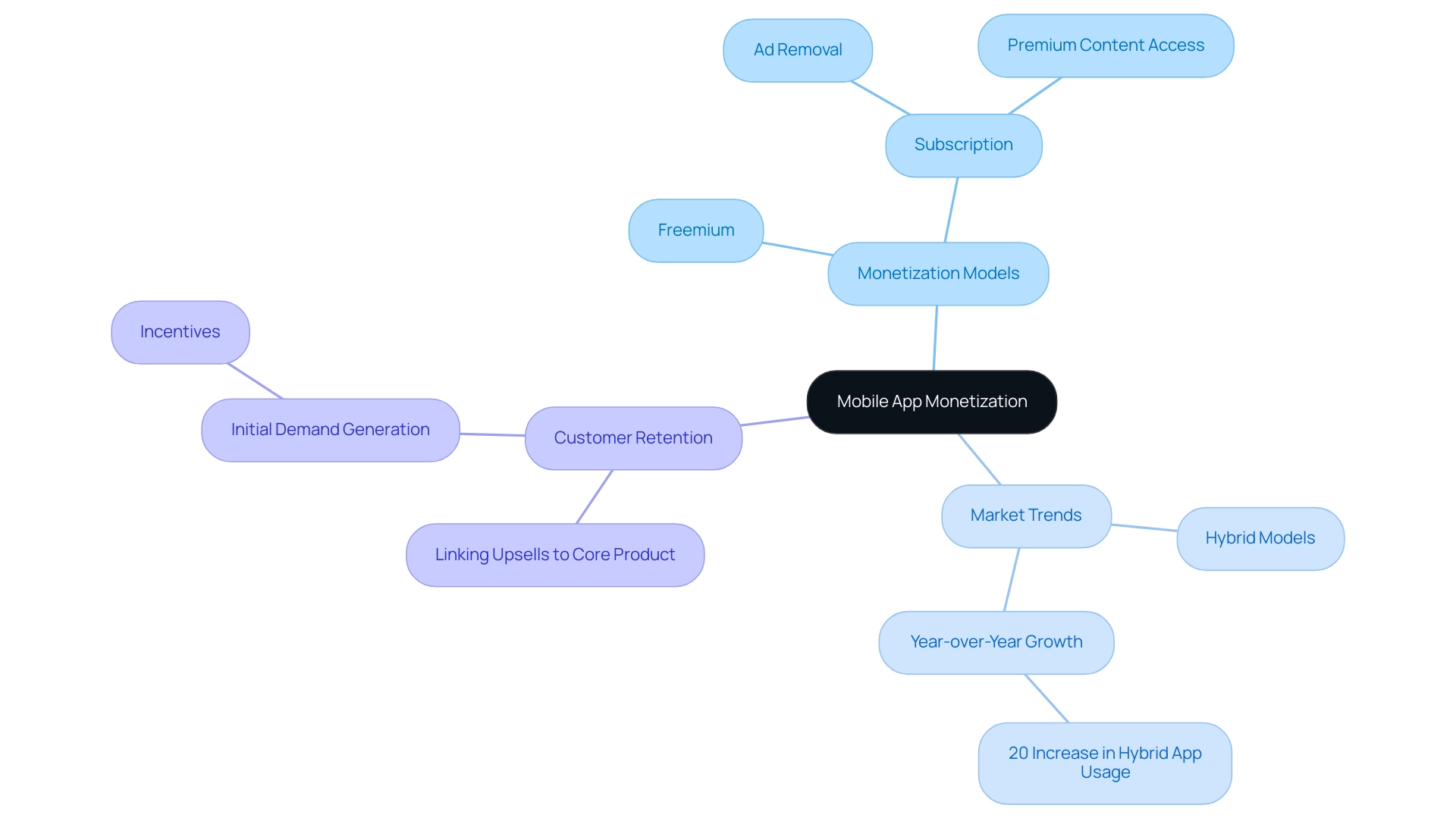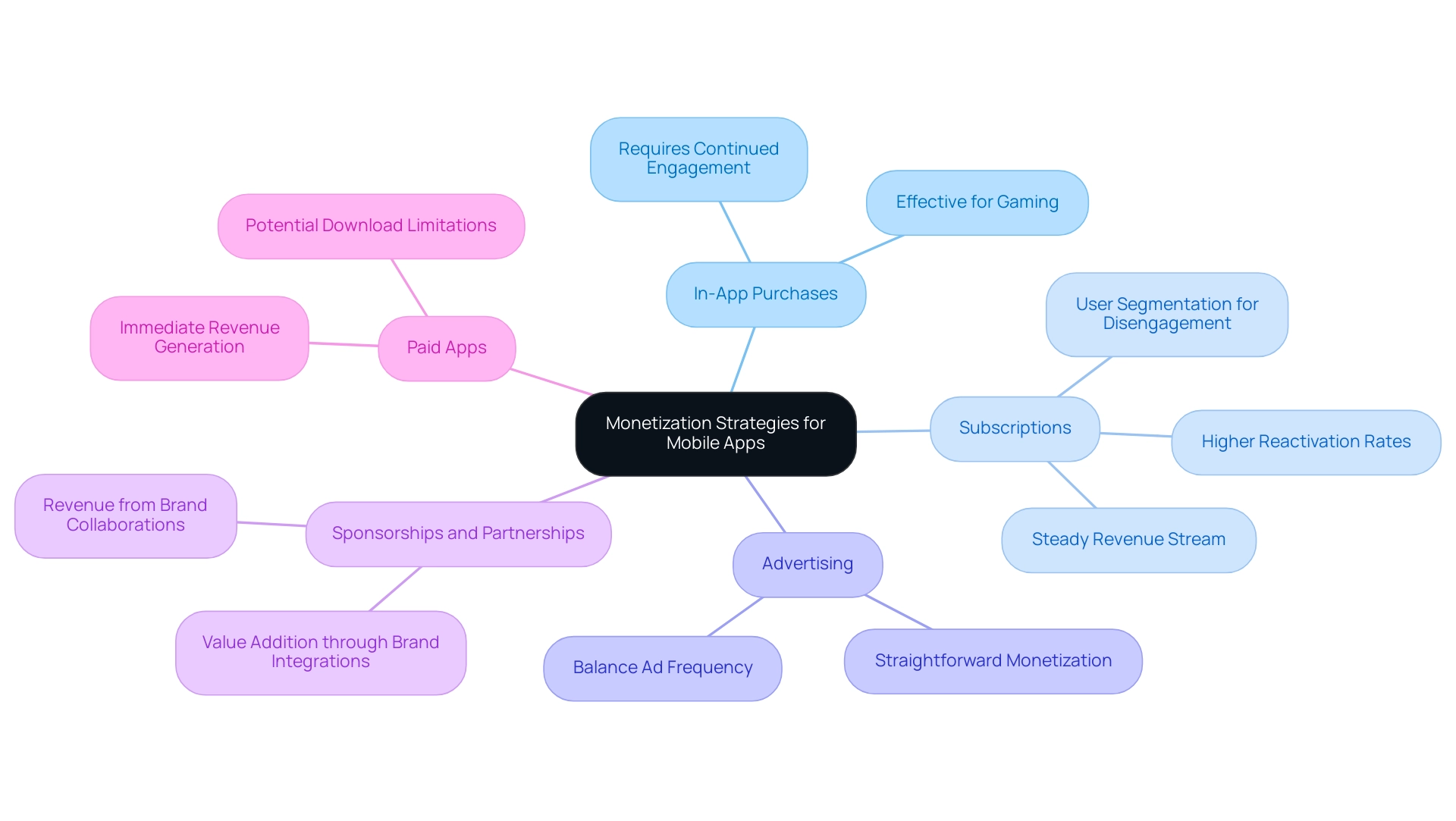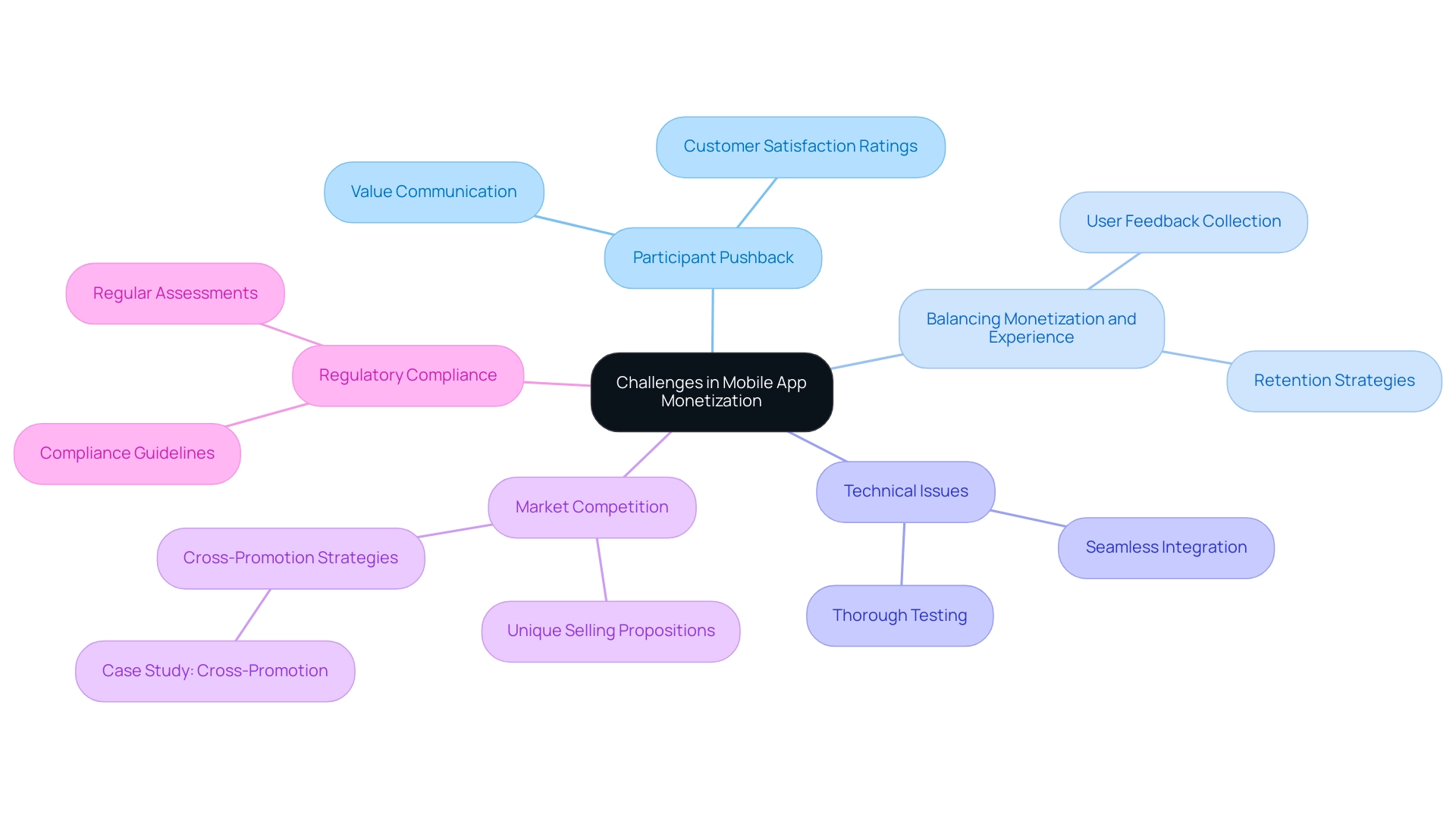Introduction
In the dynamic landscape of mobile applications, monetization has emerged as a critical factor for success. As developers strive to transform their innovative ideas into profitable ventures, understanding the various monetization strategies available becomes essential. From in-app purchases to subscription models, each approach presents unique opportunities and challenges that can significantly influence a developer's bottom line.
Furthermore, the delicate balance between generating revenue and maintaining user satisfaction cannot be overlooked. By exploring the nuances of mobile app monetization, developers can equip themselves with the knowledge needed to navigate this complex terrain, ensuring their applications not only thrive but also resonate with users in an increasingly competitive marketplace.
Understanding Mobile App Monetization: Key Concepts and Importance
The process of monetizing mobile apps encompasses the diverse methods and strategies developers employ to generate income from their applications. Mastering these revenue generation models is essential for thriving in the competitive app marketplace, where monetizing mobile apps through successful revenue strategies significantly impacts profitability and sustainability. Key concepts in this area include:
-
Monetization Models: The most prevalent models include the freemium approach, allowing individuals to download the app for free while offering in-app purchases, and subscription-based models, which create a steady stream of revenue through ongoing payments. The subscription model has gained traction recently, allowing individuals to enhance their experience—eliminating ads and accessing premium content—mirroring successful examples from platforms like Spotify and Netflix, which have reported substantial revenue growth as a result.
-
Market Trends: Staying informed about market trends and consumer behavior is crucial in choosing an effective revenue approach. As mobile app usage continues to rise, there are significant opportunities for monetizing mobile apps. The shift toward hybrid revenue models has particularly influenced the landscape, with a reported 20% year-over-year increase in hybrid app usage, indicating a growing acceptance among new entrants in the gaming market. Comprehending these trends is essential for developers seeking to synchronize their approaches with market dynamics.
-
Customer Retention: Effective revenue generation plans must also emphasize customer retention along with profit maximization. Cristian Rotari, a Product Manager focusing on revenue generation, emphasizes that linking upsells to your core product is crucial for relevance and customer satisfaction. Furthermore, firms such as LiveOps demonstrate the significance of generating initial demand through incentives, which can subsequently evolve into revenue approaches as player involvement rises. Finding a balance between customer satisfaction and monetizing mobile apps is essential for attaining lasting success in the app economy.

Exploring Different Monetization Strategies for Mobile Apps
Mobile app developers have several approaches for monetizing mobile apps to effectively generate revenue. Each approach comes with its own set of advantages and challenges, making it crucial to align the chosen strategy with the app's goals and audience expectations.
-
In-App Purchases: This model permits individuals to buy virtual goods or features directly within the app.
It has proven particularly effective in gaming applications, where engagement and participant investment are key to sustaining revenue. Notably, gaming apps account for 28% of the apps available in China, according to Statista, highlighting the vast opportunity in this sector. -
Subscriptions: Implementing a subscription model for premium features or exclusive content can lead to a steady stream of revenue.
This approach is especially beneficial for apps that provide continuous value to individuals, allowing developers to build long-term relationships with their audience. A recent case study shows that monthly subscriptions demonstrate higher reactivation rates compared to annual subscriptions, emphasizing the importance of understanding disengagement and offering incentives for re-subscribing. -
Advertising: Incorporating advertisements can be a straightforward method to monetize free apps.
However, it's essential to strike a balance in ad frequency to maintain a positive experience, as excessive ads may deter individuals from engaging with the app. -
Sponsorships and Partnerships: Collaborating with brands for sponsorships can yield substantial revenue, particularly for apps boasting a large and engaged audience.
This approach not only boosts revenue but also provides value to customers through pertinent brand integrations. -
Paid Apps: Charging individuals upfront for downloading the app can generate immediate revenue; however, this model may limit the number of downloads, as many individuals prefer free options.
By understanding the unique dynamics of each approach, developers can tailor their method for monetizing mobile apps to maximize revenue potential while also meeting client needs. Moreover, insights from Tencent Holdings Limited's financial performance (Table 78) indicate that adjusting revenue approaches in accordance with market trends will be essential for continued success, particularly with the average e-commerce conversion rate for 2024 expected to change.

Navigating Challenges in Mobile App Monetization
Monetizing mobile apps presents several challenges that developers must navigate to achieve success. Key obstacles include:
-
Participant Pushback: A significant barrier in revenue generation efforts is participant resistance. Many individuals may object to monetization strategies, perceiving them as an encroachment on their experience. To address this, it is essential to communicate the value behind these efforts clearly. As noted by Katarzyna Sobczak-Rosochacka, Head of Marketing,
How do we reach them with our messages in a world saturated with communication?
This highlights the significance of creating clear, value-oriented messaging to promote understanding and acceptance among individuals. Significantly, with an average rating of 4.9 out of 5 from 311 votes, customer satisfaction is paramount in shaping these strategies. -
Balancing Monetization and Experience: Achieving a harmonious balance between revenue generation and satisfaction is critical. Consistently gathering feedback from individuals is essential for comprehending their viewpoints and modifying approaches accordingly. Apps that successfully integrate monetizing mobile apps without compromising the experience of individuals often see better retention and satisfaction rates.
-
Technical Issues: The implementation of monetization features can lead to technical challenges. Developers should conduct thorough testing of new strategies to ensure they do not disrupt the experience of those utilizing the application. A seamless integration is key to maintaining consumer trust and engagement.
-
Market Competition: The app market is highly saturated, making it imperative for developers to identify their unique selling propositions (USPS). For instance, a case study titled 'How Effective is Cross-Promotion?' demonstrates that cross-promoting applications with shared interests can significantly enhance adoption rates and revenue generation, with 54% of organizations attributing over 20% of their income to such partnerships. Differentiating the app through innovative features or exceptional customer service can help it stand out in a crowded marketplace.
-
Regulatory Compliance: Staying informed about regulations surrounding in-app purchases and advertising is crucial to avoid potential legal pitfalls. Regular assessments of compliance guidelines will aid in guaranteeing adherence and reducing risks linked to non-compliance.
Furthermore, analyzing trends in successful applications such as YouTube and Google One, which dominated the subscription app market in 2021, can offer insights into effective revenue strategies. Tackling these challenges in advance can greatly improve the likelihood of successful revenue generation through monetizing mobile apps while preserving a positive experience for participants.

The Role of User Experience in Successful App Monetization
User experience is a cornerstone of monetizing mobile apps, as it directly influences user engagement and revenue generation. In fact, it takes less than 500ms to make a good first impression, emphasizing the need for a well-designed interface. Here are essential strategies to enhance revenue generation through user-centric design:
-
User-Centric Design: Prioritize user-centric design principles when developing your app. Ensure that features for monetizing mobile apps are seamlessly integrated without disrupting core functionalities. A well-structured interface improves customer satisfaction and promotes engagement with revenue options.
-
Feedback Loops: Establish strong feedback loops by consistently seeking input from participants. This practice is essential for comprehending needs and preferences, enabling you to enhance your strategies for monetizing mobile apps effectively. Engaging individuals in this manner not only enhances satisfaction but also promotes loyalty. Usability testing methods can help identify and address usability issues, optimize navigation, and maximize customer satisfaction, further enhancing feedback collection.
-
Value Proposition: Clearly articulate the value of your paid features and in-app purchases when monetizing mobile apps. Users are more inclined to spend money when they recognize a tangible benefit. Highlight how these features enhance their experience, thereby justifying the investment.
-
Testing and Iteration: Adopt a culture of continuous improvement through rigorous testing and iteration. Conduct A/B testing to assess participant reactions to various revenue strategies, gaining insights into what connects best with your audience. This data-driven methodology enables you to optimize strategies effectively.
-
Retention Strategies: Focus on strategies that enhance retention by delivering ongoing value and engagement through your app. Retained individuals are significantly more likely to convert into paying customers over time, making retention a crucial aspect of monetizing mobile apps. As evidenced in the casual dating app sector, where Momo and Tantan dominate with about 66 million monthly active users, maintaining user interest can lead to sustained growth and profitability.

Conclusion
Mobile app monetization is a multifaceted endeavor that requires a comprehensive understanding of various strategies and market dynamics. Developers must navigate a range of monetization models, including:
- In-app purchases
- Subscriptions
- Advertising
- Sponsorships
Each model presents distinct advantages and challenges. By aligning the chosen monetization strategy with the app's goals and user expectations, developers can unlock significant revenue potential while enhancing user satisfaction.
However, the path to successful monetization is fraught with challenges, including user pushback and the need to balance revenue generation with user experience. Clear communication of the value behind monetization efforts, coupled with a commitment to user-centric design, is essential for fostering acceptance among users. Regular feedback loops and a focus on retention strategies can further bolster user engagement, creating a loyal customer base that contributes to long-term success.
Ultimately, the key to thriving in the competitive app marketplace lies in a nuanced understanding of both monetization strategies and user experience. By continuously adapting to market trends and prioritizing user satisfaction, developers can ensure their applications not only generate revenue but also resonate deeply with their audience. In this ever-evolving landscape, a proactive approach to monetization will be instrumental in achieving sustainable growth and profitability.





